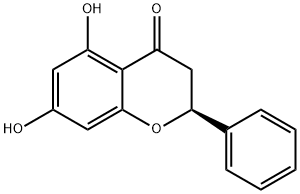Pinocembrin is a flavonoid that has been found in Eucalyptus, and has diverse biological activities. It induces apoptosis in, and inhibits the migration of, SKOV3 ovarian cancer cells when used at a concentration of 200 μM. Pinocembrin (5 mg/kg) reduces lesion volume, as well as brain microglial activation and production of IL-1β, IL-6, and TNF-α in a mouse model of collagenase-induced intracerebral hemorrhage (ICH). It prevents increases in plasma and kidney malondialdehyde (MDA) levels, glomeruli lobulation, mesangial expansion, and tubule vacuolization and occlusion, and it decreases hepatic cholesterol, triglyceride, and LDL levels in a rat model of diabetic nephropathy. Pinocembrin (20 and 50 mg/kg) reduces pulmonary edema, as well as neutrophil, lymphocyte, and macrophage infiltration in a mouse model of LPS-induced lung injury.

